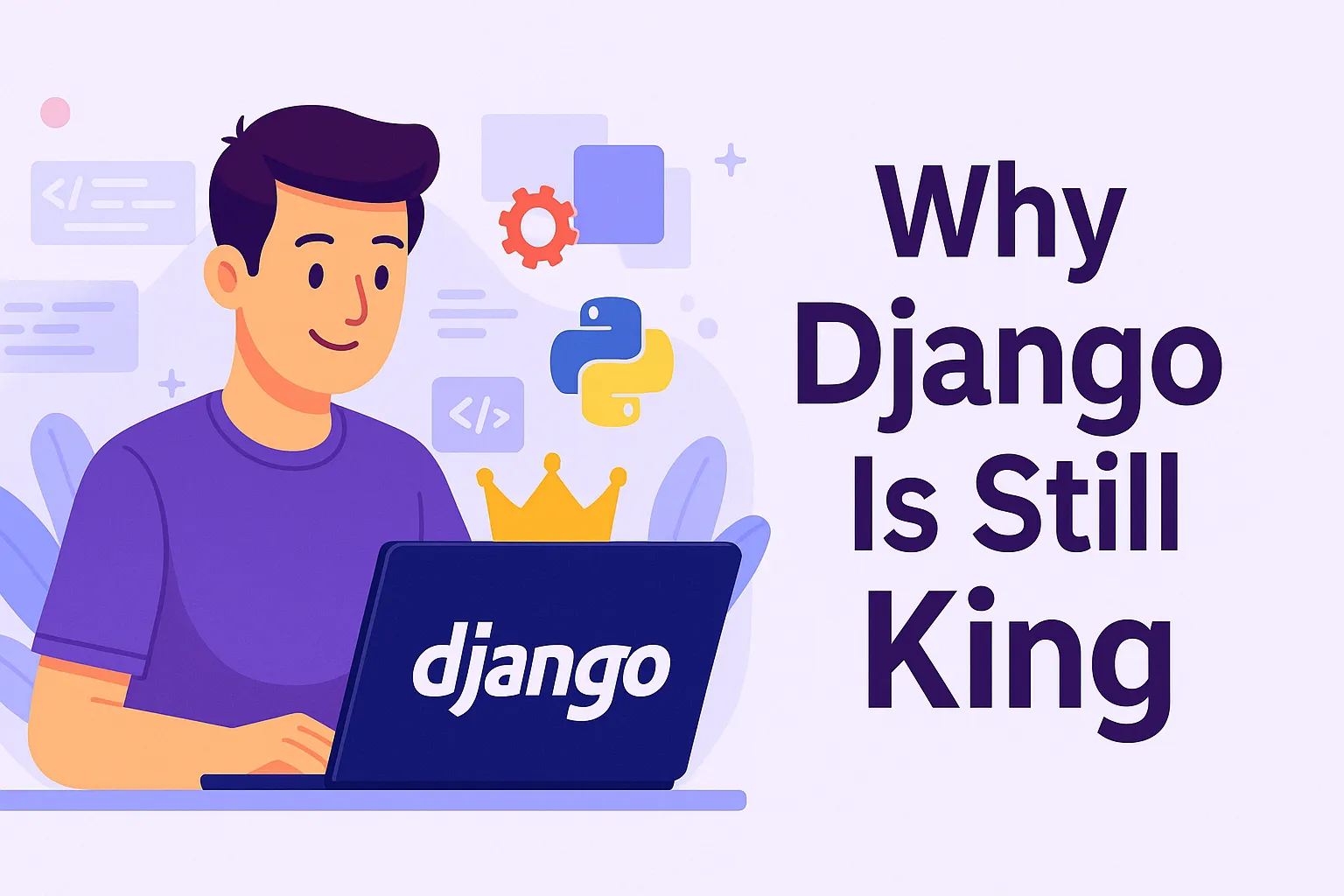Why Django Is Still King in the Era of JavaScript Hype

Let’s be honest, we’re living in the age of JavaScript supremacy. React is practically the default for frontend development, Next.js is the cool kid on the deployment block, and Astro is promising islands of interactivity in a sea of static HTML. Everywhere you turn, the loudest voices in web development are shouting in JSX.
JavaScript isn’t just the lingua franca of the frontend anymore, it’s creeping into everything: backends with Node.js, mobile with React Native, desktop apps with Electron, even game engines and IoT scripts. It’s the duct tape of modern dev, and while that's impressive, it's also... a little much.
“JavaScript is everywhere — even where it has no business being.”
I’ve been there. I’ve built with React. I’ve explored Vue. I’ve stood in the endless line of devs trying to piece together a full-stack experience using a mix of JS frameworks, routers, build tools, headless CMSes, and third-party services duct-taped into something functional.
And yet, every time, I found myself circling back and asking: Why did I just spend hours configuring basic features that should’ve been included by default? Or Why do I need four NPM packages to do what one Python module could’ve handled?
The truth? JavaScript frameworks are powerful, sure, but the obsession with pushing JS into every corner of web development has created a bloated, overengineered ecosystem where complexity is worn like a badge of honor. We've gone from “use the right tool for the job” to “use JavaScript for every job, no matter how wrong it feels.”
This isn’t about hating JavaScript, it’s about questioning the blind loyalty. And once you do, once you’ve tasted a dev experience that doesn’t feel like you're constantly debugging your own build pipeline... it’s hard to go back.
Enter Django: The Underrated Powerhouse
While the JS crowd is busy chasing trends and chaining dependencies like they're crafting a potion, Django stands there like a seasoned war general — calm, prepared, and absolutely unbothered.
It’s not new. It’s not flashy. It doesn’t come with a fancy frontend logo or a hype-driven launch video every six months. But what it does come with is everything you actually need to build and scale web applications right out of the box.
Authentication? Built-in. Admin panel? Built-in. Routing, templating, ORM, middleware, security features? All batteries included. No plugin scavenger hunt. No "just install these 12 packages first." You install Django, you get to work.
There’s no
npm install --save-existential-dreadhere. Justpip install django— and you’re already halfway to MVP.
And it’s not just easy — it’s battle-tested. This framework has powered sites like Instagram, Mozilla, and Pinterest. Yet somehow, it still gets sidelined by newer devs who think modern has to mean “JavaScript-heavy.”
The truth? Django is modern. It’s just not trying to look like it’s solving a problem it already solved a decade ago.
What Makes Django King
Let’s break it down. Django doesn’t just show up, it shows out, especially when it comes to the things that actually matter in real-world development.
🛠 Built-in Admin Panel
Right after installing Django, you’re greeted with a fully functional admin interface. Not a CLI. Not a readme telling you how to build one. A real, polished, browser-based admin panel.
You can manage users, content, permissions, and models — without writing a single line of frontend code.
CRUD? Done. Auth? Done. Dashboard? Already there.
React devs are still setting up Firebase.
🔐 Security Features
Django ships with CSRF protection, SQL injection defense, XSS prevention, and a robust auth system baked right in. You don’t have to remember to secure things — it’s secure by default.
Meanwhile, in some stacks, you’re still arguing on Twitter about which CORS middleware actually works.
🧠 ORM and Query Power
Django’s ORM hits that sweet spot between power and elegance. Querysets are readable, efficient, and you can chain them like poetry. No raw SQL headaches. No ORM boilerplate hell like TypeORM or Sequelize.
And if you do need raw SQL? Django handles that too but safely.
⚡️ Async Support
Yes, Django can do async. It’s not stuck in 2008. With async views, support for ASGI, and tools like Django Channels, you can go real-time when the app demands it and stay synchronous when it doesn’t.
No need to abandon the ship for Node.js when you want sockets or background tasks.
📈 Scalability and Modularity
Django isn’t just for personal blogs and hobby projects. It’s run massive platforms like Instagram, Disqus, and Pinterest.
The architecture is modular, clean, and production-ready from day one. You’re not duct-taping packages together — you’re plugging into a mature system built to scale.
It’s not just a framework. It’s a foundation.
Why It’s Better Than the JS Mess (Sometimes)
Here’s the thing, modern JavaScript stacks are powerful, but they’re also exhausting. Every tool comes with three tools under it. Every decision opens up five more decisions.
Need routing? Pick a router. Need state management? Pick a library. Need to fetch data? Axios or SWR or React Query or fetch or…?
By the time you've finished wiring everything together, you're burned out and still don’t have user auth.
JavaScript fatigue is real. Every solution spawns another ecosystem of problems.
Now enter Django. You start with structure. You’re not inventing your own folder architecture. You’re not gluing services together just to handle basic CRUD. You’re not stuck wondering where to put business logic.
It’s all there, with a clear convention, and a proven way of doing things.
No YAML-driven deployments. No hydration nightmares. No split-brain architecture between the backend and frontend.
With Django, you build the app, not the environment for the app.
Common Counterarguments (and Counterpunches)
Every time Django steps into the spotlight, a familiar chorus of critics starts chirping. Let’s address these objections head-on and return fire with facts.
🗣️ “Django is old.”
Oh no, not the age card. Let me guess, you think something’s only good if it was announced on Twitter last month with a neon logo and 500 upvotes on Hacker News?
Yes, Django is old. You know what else is old? Python — the language it's built on.
And last time I checked, Python was dominating everything from AI and machine learning to web scraping, automation, and — you guessed it — web backends.
Old doesn’t mean obsolete. It means mature, battle-tested, and wildly trusted by giants like NASA, Instagram, and Spotify.
Meanwhile, half the “modern” JS frameworks are still figuring out how not to crash during SSR.
🗣️ “It’s not real-time.”
This one’s just outdated. Django supports asynchronous views, WebSockets, and real-time communication through Django Channels. Pair it with Redis, and you’re ready to go full chat-app mode.
Want to build a real-time dashboard, chat system, notification engine? You can do that without switching to Node.js or reinventing your entire stack.
You’re not limited by Django. You’re just limited by what you know Django can do.
It’s not the sleepy, synchronous relic people think it is — it just doesn’t brag about itself every five seconds.
🗣️ “You can’t build modern UIs.”
Modern = React? Hard pass.
Django pairs beautifully with tools like Alpine.js, HTMX, and Tailwind CSS. Together, they let you build highly interactive, dynamic UIs without dragging in 500kb of JavaScript frameworks and the mental overhead of managing state across a virtual DOM.
Alpine gives you the reactivity of Vue — in your HTML.
HTMX lets you do AJAX and real-time interaction — with Django views as endpoints.
Tailwind makes your designs consistent, scalable, and clean — and your CSS actually manageable.
Modern UI doesn't have to mean full-blown SPA. You can build modern experiences with tools that stay out of your way and don’t wreck your backend sanity.
So yeah, Django hears the criticism and counters every point with substance.
It’s not flashy. It’s not trendy. But it is powerful, secure, and way more modern than most people give it credit for.
Real-World Wins
It’s easy to talk theory but let’s bring this down to earth. Because while tech Twitter debates architecture and hot takes, Django just keeps quietly winning in real-world scenarios.
I’ve personally built full-fledged web apps with Django in record time, clean architecture, user auth, admin dashboards, REST APIs are all done without ever feeling like I was wrestling the framework. No spinning wheels. No dependency deep-dives. Just productivity.
But one story that really sealed it for me came from a good friend of mine — I’ll leave their name out for privacy, but we started learning web development at roughly the same time. After we wrapped up frontend basics, they decided to go the PHP/Laravel route while I dove into Python and Django.
Fast-forward a few weeks, I get a call. They're frustrated. Laravel was “just not clicking.” The structure, the tooling, the ecosystem — it felt like too much of a fight. So I told them, “Hey, try Django. It might surprise you.” I dropped them a link to a solid beginner Django tutorial on YouTube and walked them through a few core concepts along the way.
Two days later, they called back — not to complain, but to accuse me.
“So you've been hiding this from me and just enjoying it all to yourself?!”
We both cracked up. That was not an exact quote, but trust me, the betrayal in their tone was very real.
Since then, they’ve been full Django. And like me, they’ve never looked back. There’s a reason for that — Django just gets out of your way and lets you build things that work.
And this isn’t just a “me and my friend” story. Massive companies trust Django:
- Instagram — yes, the one owned by Meta — originally built on Django.
- Disqus — one of the largest global comment systems.
- Pinterest — scaled Django to millions of users.
- Mozilla, The Washington Post, National Geographic — all have Django under the hood.
These aren't toy projects. These are production-grade, high-traffic, business-critical systems.
The bottom line: Django doesn't just win arguments — it wins projects.
The Stack You Forgot You Needed
Here’s the thing, most developers don’t start with Django. They stumble into it after a few rounds in the JS thunderdome. They’ve wrestled with SPAs, fought the good fight with React, spent too long configuring webpack or tweaking their Next.js deployment pipeline… and eventually they just want to build something that works.
That was me too. I had my React honeymoon phase — building sleek frontends, hooking them up to Django REST APIs, handling JWT authentication manually, managing CORS headaches, dealing with async data and state rehydration. All of that just to show a user dashboard.
And honestly? It burned me out.
For every bit of interactivity I gained, I was trading off clarity, simplicity, and peace of mind.
So I came back. Not to some “legacy” stack. But to a framework that actually respects my time.
Django doesn’t beg for extra packages. It doesn’t ask you to build things it already ships with. It lets you focus on what matters — the actual product.
And paired with Tailwind CSS and Alpine.js, you get the frontend flexibility you need, without the JavaScript overhead you don’t. It's clean. It's fast. It's focused.
💥 The Challenge
Think of the easiest project you can build with your current stack.
Now build it again — this time with Django.
Watch how much faster it gets.
Watch how much less code you write.
Watch how much less nonsense you deal with.
Django isn’t just “still relevant.”
It’s the stack you forgot you needed — and once you return to it, you’ll wonder why you ever left.
